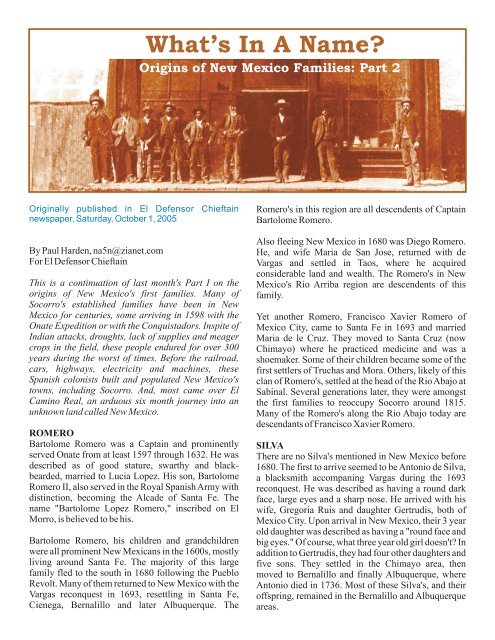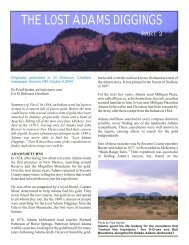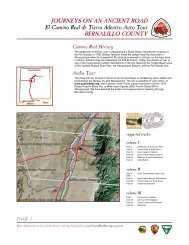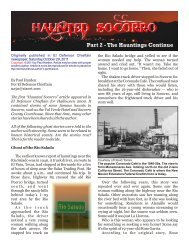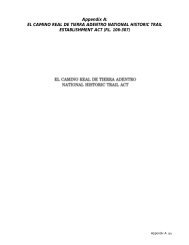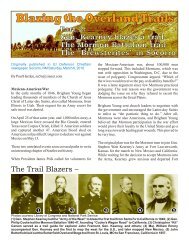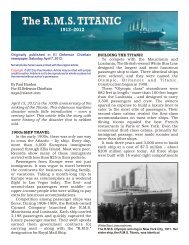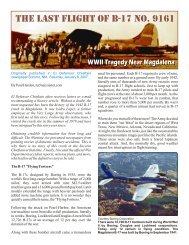What's In A Name? - El Camino Real International Heritage Center
What's In A Name? - El Camino Real International Heritage Center
What's In A Name? - El Camino Real International Heritage Center
Create successful ePaper yourself
Turn your PDF publications into a flip-book with our unique Google optimized e-Paper software.
What’s <strong>In</strong> A <strong>Name</strong>?<br />
Origins of New Mexico Families: Part 2<br />
Originally published in <strong>El</strong> Defensor Chieftain<br />
newspaper, Saturday, October 1, 2005<br />
By Paul Harden, na5n@zianet.com<br />
For <strong>El</strong> Defensor Chieftain<br />
This is a continuation of last month's Part I on the<br />
origins of New Mexico's first families. Many of<br />
Socorro's established families have been in New<br />
Mexico for centuries, some arriving in 1598 with the<br />
Onate Expedition or with the Conquistadors. <strong>In</strong>spite of<br />
<strong>In</strong>dian attacks, droughts, lack of supplies and meager<br />
crops in the field, these people endured for over 300<br />
years during the worst of times. Before the railroad,<br />
cars, highways, electricity and machines, these<br />
Spanish colonists built and populated New Mexico's<br />
towns, including Socorro. And, most came over <strong>El</strong><br />
<strong>Camino</strong> <strong>Real</strong>, an arduous six month journey into an<br />
unknown land called New Mexico.<br />
ROMERO<br />
Bartolome Romero was a Captain and prominently<br />
served Onate from at least 1597 through 1632. He was<br />
described as of good stature, swarthy and blackbearded,<br />
married to Lucia Lopez. His son, Bartolome<br />
Romero II, also served in the Royal Spanish Army with<br />
distinction, becoming the Alcade of Santa Fe. The<br />
name "Bartolome Lopez Romero," inscribed on <strong>El</strong><br />
Morro, is believed to be his.<br />
Bartolome Romero, his children and grandchildren<br />
were all prominent New Mexicans in the 1600s, mostly<br />
living around Santa Fe. The majority of this large<br />
family fled to the south in 1680 following the Pueblo<br />
Revolt. Many of them returned to New Mexico with the<br />
Vargas reconquest in 1693, resettling in Santa Fe,<br />
Cienega, Bernalillo and later Albuquerque. The<br />
Romero's in this region are all descendents of Captain<br />
Bartolome Romero.<br />
Also fleeing New Mexico in 1680 was Diego Romero.<br />
He, and wife Maria de San Jose, returned with de<br />
Vargas and settled in Taos, where he acquired<br />
considerable land and wealth. The Romero's in New<br />
Mexico's Rio Arriba region are descendents of this<br />
family.<br />
Yet another Romero, Francisco Xavier Romero of<br />
Mexico City, came to Santa Fe in 1693 and married<br />
Maria de le Cruz. They moved to Santa Cruz (now<br />
Chimayo) where he practiced medicine and was a<br />
shoemaker. Some of their children became some of the<br />
first settlers of Truchas and Mora. Others, likely of this<br />
clan of Romero's, settled at the head of the Rio Abajo at<br />
Sabinal. Several generations later, they were amongst<br />
the first families to reoccupy Socorro around 1815.<br />
Many of the Romero's along the Rio Abajo today are<br />
descendants of Francisco Xavier Romero.<br />
SILVA<br />
There are no Silva's mentioned in New Mexico before<br />
1680. The first to arrive seemed to be Antonio de Silva,<br />
a blacksmith accompaning Vargas during the 1693<br />
reconquest. He was described as having a round dark<br />
face, large eyes and a sharp nose. He arrived with his<br />
wife, Gregoria Ruis and daughter Gertrudis, both of<br />
Mexico City. Upon arrival in New Mexico, their 3 year<br />
old daughter was described as having a "round face and<br />
big eyes." Of course, what three year old girl doesn't? <strong>In</strong><br />
addition to Gertrudis, they had four other daughters and<br />
five sons. They settled in the Chimayo area, then<br />
moved to Bernalillo and finally Albuquerque, where<br />
Antonio died in 1736. Most of these Silva's, and their<br />
offspring, remained in the Bernalillo and Albuquerque<br />
areas.
The large Silva families in the Socorro area are mostly<br />
descendants of Jose Silva, a native of Zacatecas,<br />
Mexico. Jose arrived with a caravan of settlers along <strong>El</strong><br />
<strong>Camino</strong> <strong>Real</strong> in the late 1700s.<br />
<strong>In</strong> 1787, he married Maria Josefa Baca in Albuquerque.<br />
By 1816, a Jose Silva and family was living "in the Rio<br />
Abajo del Socorro." It is not known if this was Jose and<br />
Maria Silva from Zacateca, or one of his sons.<br />
Regardless, these Silva's were amongst the first<br />
families to resettle Socorro in the early 1800s.<br />
By the late-1800s, some of these Silva's had settled east<br />
of the Rio Grande, establishing a small village or<br />
estancia consisting of several families they called<br />
Guadalajara. At the obscure Guadalajara cemetery,<br />
Juan Silva, born 1858, Flavio Romero, born 1871 and<br />
Lorenzo Vigil, born 1875, are amongst those who lived<br />
at this nearly forgotten estancia east of San Pedro.<br />
TORRES<br />
Many of the Torres families in Socorro are able to trace<br />
their lineage to 1598, beginning with Juan de Torres<br />
and son Baltasar. Juan arrived with Onate with<br />
"complete armor for himself and his horse," indicating<br />
a measure of wealth. Another, Francisco Gomez de<br />
Torres, was a captain with the Conquistadors. He<br />
escorted wagon trains of supplies and colonists along<br />
<strong>El</strong> <strong>Camino</strong> <strong>Real</strong> into New Spain from Mexico City in<br />
1619 and 1621. Most of these early Torres families fled<br />
to Guadalupe del <strong>El</strong> Paso during the 1680 Pueblo<br />
Revolt to return in later years.<br />
EUGENE TORRES<br />
One of Diego's grandsons, Agustín, married Felipa<br />
Baca in Belen. Agustin and Felipa were among the first<br />
families to reoccupy Socorro in 1815. One of their sons,<br />
Jose, married the 1839 fiesta queen, Maria Gallegos.<br />
Jose was a wagon master for the Army, running supply<br />
wagons between Forts Union and Craig during the<br />
Civil War and into the 1870s. After that, he operated a<br />
large farm along today's Cuba road. Jose and Maria had<br />
13 children. However, Jose's brother, Ysidro, died in<br />
1886, leaving 6 more children for them to raise. No<br />
wonder Jose had such a large farm!<br />
Meanwhile, Jose's sister, Maria Paula Torres, married<br />
Army soldier Samuel Zimmerly, the genesis of this<br />
long line of Socorro families. One of Jose's daughters,<br />
<strong>El</strong>isia, also married a soldier, Richard Stackpole, and<br />
later, son Hermino married Sam and Maria Zimmerly's<br />
daughter, Gertrudes. Suddenly, it seemed half of<br />
booming Socorro was related to the Torres family!<br />
Jumping ahead a couple of generations, some of these<br />
Torres' had spread from Monticello to working in the<br />
mines at Kelly. <strong>In</strong> Magdalena, Eugene Torres married<br />
Euna Cuvillier, raising 5 boys, Paul, Dave, Tom, Max,<br />
Arthur, and their poor outnumbered sister, Mary.<br />
Eugene operated a store in Magdalena until relocating<br />
to Socorro in 1955. Here he opened the Western Auto<br />
One family that did not flee during the Pueblo Revolt<br />
was Fra Tomas de Torres and his brother Sebastian,<br />
natives of Teposotlan, Mexico. Fra Tomas de Torres,<br />
and 20 other Franciscans, were killed in the early hours<br />
of the1680 revolt. Sebastian Torres, his wife and child<br />
were also killed, all amongst the first to be martyred<br />
during the revolt.<br />
The man responsible for repopulating New Mexico<br />
with Torres' following the revolt was clearly Diego de<br />
Torres. Settling in Chama by 1731, he had two children<br />
by first wife Rosa de Varela, another eight by second<br />
wife Maria Martín, while third wife Rafaela Baca bore<br />
him six children more. His 16 children and nearly a<br />
hundred grandchildren quickly populated New Mexico<br />
from Chama to Albuquerque and into the Rio Abajo.<br />
Of the numerous Torres families in Socorro, three are<br />
presented here: the Eugene Torres, Jose Torres and<br />
Anastacio Torres familes.<br />
Photos: Paul Harden<br />
ABOVE: Gambles<br />
Hardware has been<br />
at it’s present<br />
location in Socorro<br />
since 1960.<br />
RIGHT: Founded by<br />
Eugene and Eula<br />
Torres, Gambles is<br />
operated today by<br />
sons David and<br />
Paul Torres.
Store on the southwest corner of California and<br />
Manzanares streets, renaming the growing business to<br />
Gambles in 1957. However, the business was<br />
condemned in 1960 by the State Highway Department<br />
when California Street was expanded from 2-lanes to<br />
the present 4-lanes. The historic building that housed<br />
Eugene's Gambles store was razed, along with dozens<br />
of other businesses along California Street.<br />
About this same time, a fire destroyed the Grimes<br />
Department Store. Eugene Torres purchased the<br />
burned-out building and after considerable repairs,<br />
reopened his business at the new location on<br />
Manazanares. Over the following years, Gamble's<br />
expanded into the neighboring stores formerly<br />
occupied by Fortune's Clothing Store, Jessie's Apparel<br />
and Petty's Confectionery.<br />
Today, Gambles True Value Hardware is operated by<br />
Eugene and Eula's sons, Dave and Paul Torres.<br />
Gambles has served Socorro with standard hardware<br />
items, appliances, and hard-to-find items for nearly 50<br />
years, the longest continuously operated hardware in<br />
Socorro.<br />
JOSE E. TORRES<br />
Not related to the Eugene Torres family, another early<br />
Socorro family was Balentin and Josepha Torres. One<br />
of their sons, Jose E. Torres, born in 1858, married<br />
Guadalupe Padilla in 1889. Jose was a local<br />
businessman who also became prominent in local<br />
politics. He was elected as Socorro's Mayor in 1899,<br />
Probate Judge in 1903, and County Treasurer in 1905.<br />
Jose E. and Guadalupe Torres had eight children,<br />
among them sons Valentin and Joseph.<br />
Valentin became involved in business at an early age.<br />
Purchasing an old adobe store on the corner of<br />
California and Abeyta streets in 1932, Valentin started<br />
the Sunset Bar. This was when California Street was a<br />
Courtesy Max Torres<br />
Jose E. Torres, in<br />
1899, when he was<br />
elected as Socorro’s<br />
mayor.<br />
Courtesy Max Torres<br />
The original Sunset Bar, about 1932. It was located<br />
where today’s business stands, on the corner of<br />
California and Abeyta streets.<br />
Photo by Paul Harden<br />
Arhur “Max” Torres (left) and son Chris Torres (right)<br />
are two of the four generations that have run Sunset<br />
Liquors for 73 years.<br />
narrow, 2-lane dirt road. By the 1950s, the popular bar<br />
had simply outgrown the small adobe structure. On a<br />
1951 trip to Albuquerque, Valentin was struck by the<br />
architecture of a new service station being built on<br />
Route 66 in the Nob Hill area. Sitting on the curb across<br />
the street, he sketched the new "modern" building with<br />
it's huge plate glass windows and curved front as the<br />
model for his new bar. By year's end, Valentin, and<br />
brother Joseph, had torn down the old adobe bar and the<br />
new building was being framed.<br />
<strong>In</strong> 1952, Valentin and Joe opened the new Sunset<br />
Lounge and Package Liquor store, with it's large plate<br />
glass windows and curved front, being one of the more<br />
modern buildings in Socorro at the time - built from a
simple sketch. Following the unexpected death of<br />
Valentin in 1955, the business was run by brother<br />
Joseph, then later by Joseph's son, Max Torres, for<br />
many years.<br />
<strong>In</strong> addition to his interest in Sunset Liquors, Joseph<br />
"Joe" Torres is also well remembered as the Chief of<br />
Police under Socorro Mayor Holm O. Bursum Jr.,<br />
serving from 1949 through 1958.<br />
Today, Sunset Liquors is operated by Max Torres' sons<br />
Chris, Joe and Darren. Counting grandson David Jr.,<br />
who works at the package store as well, four<br />
generations of the Torres family have operated this<br />
Socorro landmark business. It is one of Socorro's<br />
longest continuously run businesses, now in it's 73rd<br />
year.<br />
<strong>El</strong> Defensor Chieftain<br />
Anastacio “A.C.”<br />
Torres founded <strong>El</strong><br />
Defensor newspaper<br />
in 1904, which he<br />
published<br />
continuously for 55<br />
years.<br />
Other prominent Socorro businesses were started by<br />
this Torres family, such as the <strong>El</strong> <strong>Camino</strong> Restaurant<br />
and Motel, and Randy's Ace Hardware.<br />
ANASTACIO TORRES<br />
Another Torres family that left an indelible mark on<br />
Socorro was Anastacio "A.C." Torres. Born in 1868 to<br />
Canuto Torres and Isabelita Padilla y Abeyta, he was<br />
educated at the Sisters of Loretto Convent in Socorro.<br />
<strong>In</strong> 1883 he worked as a clerk at the Price Brothers<br />
Mercantile store in San Antonio. Studying to be an<br />
educator, he mastered both the Spanish and English<br />
languages. With these skills, he worked as a school<br />
teacher and court interpreter in Socorro for many years.<br />
<strong>In</strong> 1890, he was also elected City Clerk.<br />
<strong>In</strong> 1904, while teaching 3rd grade in San Antonio, he<br />
bought the <strong>El</strong> Republicano Printing Company. Armed<br />
with a printing press and his language skills, he<br />
published the first edition of Socorro's bilingual<br />
newspaper, the "<strong>El</strong> Defensor," on May 7, 1904.<br />
He married Margarita Montoya of Socorro in 1915,<br />
raising 2 sons and 5 daughters. While still the publisher<br />
and editor of the <strong>El</strong> Defensor, he was elected as State<br />
Representative in 1931, and the following year as State<br />
Senator, representing Socorro and Catron Counties for<br />
two terms. From 1953 through 1957, A.C. Torres<br />
proudly added "The Free State of Socorro" to the<br />
newspaper's masthead, being a spirited supporter of the<br />
movement.<br />
<strong>In</strong> 1957, A.C. Torres semi-retired. After all, he was now<br />
87 years old! He sold the paper to the Morgan family<br />
from Kansas, though he stayed on as Honorary Editor<br />
and continued writing the Spanish language portions of<br />
Photo: Paul Harden<br />
The old “Torres building” on the corner of U.S. 85 and<br />
Spring Street, was the newspaper office and printing<br />
plant for <strong>El</strong> Defensor from 1904 until 1959.<br />
the paper. <strong>In</strong> 1959, the Morgan's ceased publishing the<br />
<strong>El</strong> Defensor for personal reasons. At 89 years of age,<br />
A.C. Torres was in no position to reassume the daily<br />
operation of the paper.<br />
<strong>In</strong> October 1959, he merged his beloved newspaper<br />
with the Socorro Chieftain. The first issue of the<br />
combined "Socorro <strong>El</strong> Defensor-Chieftain" was<br />
published on November 3, 1959.<br />
Printing the <strong>El</strong> Defensor for 55 years, Anastacio C.<br />
Torres was the longest enduring publisher and editor in<br />
Socorro's history, and perhaps in New Mexico. The<br />
merger of these two institutions has brought continuous<br />
newspaper service to Socorro County for over 120<br />
years. The <strong>El</strong> Defensor Chieftain is recognized as the<br />
3rd oldest newspaper in New Mexico, and one of the<br />
longest running historical records in the Southwest.
PINO<br />
The first known Pino in New Mexico appears to be Juan<br />
Bautista Pino, born in Mexico in 1709 and a traveling<br />
merchant along the <strong>El</strong> <strong>Camino</strong> <strong>Real</strong>. He was a financier<br />
and merchant for the periodic supply caravans bringing<br />
in the much needed supplies from Chihuahua and<br />
Mexico City. By 1747, he had established a residence<br />
near Isleta Pueblo, though apparently his wife, Petra<br />
Davila y Calle, and their two sons, remained in Mexico<br />
City.<br />
When sons Joaquin Jose and Mateo Jose became<br />
adults, they joined their father in the merchant trade.<br />
Joaquin married Barbara Sanchez in 1764 and lived in<br />
Tome, bearing two sons and a daughter. His brother<br />
Mateo Jose married Teresa Sanchez, likely the sister of<br />
his brother's wife, Barbara. Teresa died giving birth to<br />
their 7th child. Mateo then married Maria Roybal, who<br />
bore him two more children.<br />
Courtesy Vincent Pino<br />
Nicholas Pino moved to Socorro in 1840, serving as a<br />
merchant and a colonel in the New Mexico Militia.<br />
Mateo's son, Pedro Bautista Pino, also lived near Isleta.<br />
He had four children with first wife Manuela Gabaldon.<br />
Following her death, he married Lugarde Lucero, who<br />
bore him eight more children. The family lived in<br />
Tome. Pedro was also the Deputy from New Mexico to<br />
the Spanish Cortes. <strong>In</strong> 1810, he was part of the<br />
expedition south of Tome that recommended the<br />
resettlement of the Rio Abajo region. As a result of this<br />
expedition, the first families were allowed to resettle in<br />
the original Socorro Spanish land grant a few years<br />
later, including several families of Pino's. Church<br />
records indicate Vicente Pino and Delores Baca were<br />
married in the newly rebuilt San Miguel church in<br />
1830. By the 1860 census, 22 Pino families were<br />
recorded in Socorro County.<br />
Back to Pedro Pino, in 1816, he married for the third<br />
time to Maria Baca, who gave him four more children.<br />
Of these, two were sons Nicholas de Jesus and Miguel<br />
Estanislado Pino, born 1819 and 1921 respectively in<br />
Galisteo. <strong>In</strong> later years, both Miguel and Nicholas<br />
became historical figures. Colonel Miguel Pino was the<br />
commander of the 2nd Regiment of New Mexico<br />
Volunteers, fighting alongside Col. Kit Carson and his<br />
regiment of volunteers at the Battle of Val Verde on<br />
February 21, 1862.<br />
Brother Nicholas moved to Socorro as a young adult<br />
around 1840, where he continued the Pino family<br />
tradition as a merchant. <strong>In</strong> 1842, he married Juana<br />
Rascon. For much of his life, Nicholas was also active<br />
with the New Mexico Militia garrisoned at Lemitar and<br />
Socorro. During the Battle of Val Verde, he<br />
commanded the 2nd New Mexico Militia. Following<br />
Photo: Paul Harden<br />
Socorroan Jimmy R. Pino is a distant relative to Civil<br />
War colonels Miguel and Nicholas Pino.<br />
the battle, Nicholas Pino and 280 soldiers hurried to<br />
protect Socorro against the Confederates. Vastly<br />
outnumbered, Nicholas had the unfortunate distinction<br />
of surrendering Socorro to the Confederates, but not<br />
until negotiating the safe treatment to the peoples of<br />
Socorro.<br />
Today, brothers Joe, Vincent and Jimmy R. Pino are the<br />
children of Lucas and Arelina Pino. Their grandparents,<br />
Vicente and Ana Maria Pino were married in San<br />
Marcial in 1903. Vicente's grandfather was none other<br />
than Col. Nicholas Pino.
SARRACINO<br />
Like the first Pino families, merchants from Mexico<br />
City, the Sarracino's were merchants from Chihuahua.<br />
The first into New Mexico was Jose Rafael Sarracino in<br />
the late 1700s. He married Maria Gutierrez in 1787.<br />
Like many of the caravan merchants during this time,<br />
his wife and children resided in Chihuahua while Jose<br />
was "on the trail." Being a merchant on <strong>El</strong> <strong>Camino</strong> <strong>Real</strong><br />
was a political appointment and a coveted job for the<br />
profits that could be made. For this reason, the male<br />
children of these merchants were brought into the<br />
"family business." The two sons of Jose Sarracino<br />
likewise became <strong>El</strong> <strong>Camino</strong> <strong>Real</strong> merchants, residing<br />
in Santa Fe with their families around 1820.<br />
However, with the arrival of the Santa Fe Trail, and<br />
later the railroad, higher quality goods at lower prices<br />
were brought into New Mexico (and without the<br />
political corruption from Mexico). The <strong>El</strong> <strong>Camino</strong> <strong>Real</strong><br />
began to die, and along with it, the merchants and their<br />
prosperity.<br />
The two Sarracino merchants were suddenly out of a<br />
job, becoming ranchers east of Santa Fe and in Truchas.<br />
They quickly proved to be good ranchers. Shortly after<br />
the Civil War, several families of Sarracino's ventured<br />
into the Rio Abajo and southern New Mexico, running<br />
ranches from La Joya to the Diamond A near Deming,<br />
and of course, near Socorro.<br />
By the 1880s, the Sarracino Ranch ran from the Rio<br />
Salado to about U.S. 60 near Water Canyon. Some of<br />
the Sarracino's in today's Socorro are descendants of<br />
these successful sheep and cattle families.<br />
PADILLA<br />
Jose de Padilla was the first of this family name in New<br />
Mexico, though it is not known how or when he arrived,<br />
other than in 1668 he was mustered in as a captain in<br />
New Spain. Twelve years later, during the Pueblo<br />
Revolt, he fled to Guadalupe del Paso "with his wife,<br />
five children and six servants." He served as an escort<br />
on the <strong>El</strong> Paso to Mexico City arm of <strong>El</strong> <strong>Camino</strong> <strong>Real</strong>,<br />
twice that is known, in 1683 and again in 1689.<br />
Jose Padilla, wife Maria, and son Jose Junior remained<br />
refugees from New Mexico in Senecu del Paso the rest<br />
of their lives, while sons Juan and Diego returned to<br />
New Mexico in 1693 with the de Vargas reconquest.<br />
Son Juan de Padilla settled in the Santa Cruz (Chimayo)<br />
area, marrying Margarita Martín, raising two sons,<br />
Julian and Tomas. Juan must have died around 1730,<br />
Photo: Paul Harden<br />
Many of the early Padilla families settled in San<br />
Antonio, San Pedro and La Joya. Pillar Padilla, of<br />
Polvadera, is the son of Frank Padilla, of San Antonio,<br />
and Isabel Enriques, of Mesilla.<br />
for church records show "Margarita, a widow, married<br />
Bernardo Roybal." Bernardo and Margarita finished<br />
raising the two Padilla sons, in addition to their own<br />
children carrying the Roybal name. All of these<br />
children married and had their own children in and<br />
around the Santa Fe area into the late 1700s. Tomas de<br />
Padilla was still serving as a soldier at the Sante Fe<br />
Presidio in 1766.<br />
Jose's son Diego also returned to New Mexico. He<br />
married Catalina de Salazar in 1706. They had two<br />
sons, Pedro and Luis, before Catalina died a few years<br />
later. Diego then married Maria Baca in Bernalillo in<br />
1713, who bore him five additional sons and three<br />
daughters. These Padilla's lived from Bernalillo to<br />
Santa Fe. When the Rio Abajo was reopened for<br />
settlement, numerous Padilla families settled in La<br />
Joya, Socorro, San Antonio and Don Pedro.<br />
VARGAS<br />
The recolonization of New Mexico in 1693 was led by<br />
the great reconquistador Vargas, whose full name was<br />
Don Diego de Vargas Zapata Lujan Ponce de Leon.<br />
What happened to him and his family?<br />
He was from a long line of noble Castillian families that<br />
was very loyal to Spain. <strong>In</strong> the new world, de Vargas<br />
was the man that led the exiled families back into New
Mexico following the 1680 Pueblo Revolt. His<br />
reconquest opened the doors for the resettlement of<br />
New Mexico that has not been broken since.<br />
Unfortunately, he did not have any known children in<br />
New Mexico to carry on his name following his sudden<br />
death in Bernalillo in 1704. It is not known if he had any<br />
children in Spain.<br />
Two brothers, Manuel Fernandez de Vargas and<br />
Sebastian de Vargas, entered New Mexico in 1693<br />
along with the reconquest, though not directly related<br />
to the famous de Vargas. These Vargas brothers were<br />
from Guadalajara. Manuel was a tailor, marrying Luisa<br />
de la Cruz at San Lorenzo in 1695 at 19 years of age. He<br />
must have died young, as in 1716, his wife Luisa was<br />
listed as "a widow living in Chimayo."<br />
Older brother Sabastian married Maria de Layva in<br />
1696 at 22 years old. <strong>In</strong> the early 1700s, he was a<br />
landowner around Santa Fe and a captain in the Royal<br />
Army. After a long marriage and several children, his<br />
wife died in 1742. Sabastian de Vargas lived a long,<br />
fruitful life, dying in 1757 at 80 years of age. The<br />
handful of colonial Vargas families in present day New<br />
Mexico are decendants of Manual and Sabastian de<br />
Vargas, not the reconquistador Don Diego de Vargas.<br />
This has been a small sampling of Socorro's founding<br />
families. Many families were not included due to the<br />
limitation of space. Others will be presented in future<br />
articles.<br />
Next month: Part I of the history of <strong>El</strong> <strong>Camino</strong> <strong>Real</strong> de<br />
Tierra Adentro.<br />
=====================<br />
Some of the references used in this article:<br />
Historical documents of the Onate and Vargas<br />
expeditions, "Origins of New Mexico Families" by<br />
Fray Angelico Chavez, courtesy Sam Pino, the New<br />
Mexico Hispanic Genealogical database, "Legacy of<br />
Honor," Jacquelin Maketa, various issues of the <strong>El</strong><br />
Defensor Chieftain and <strong>El</strong> Defensor, and interviews<br />
with Jimmy R. Pino, Pilar Padilla, Max and Chris<br />
Torres, Dave and Paul Torres, and others.


